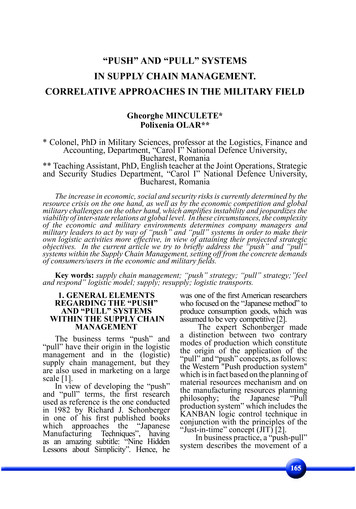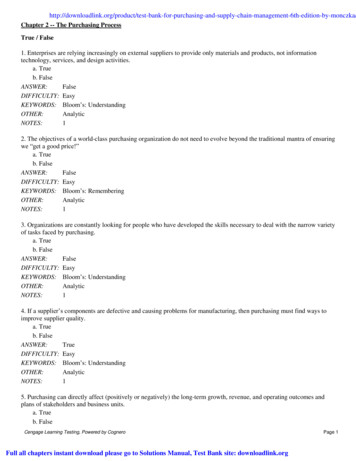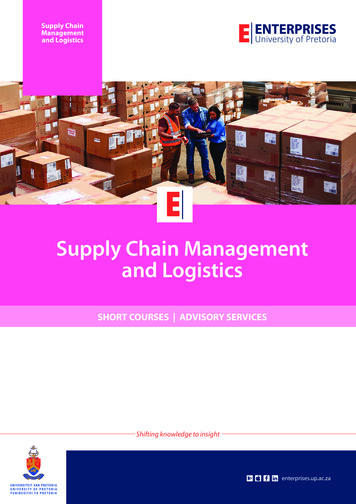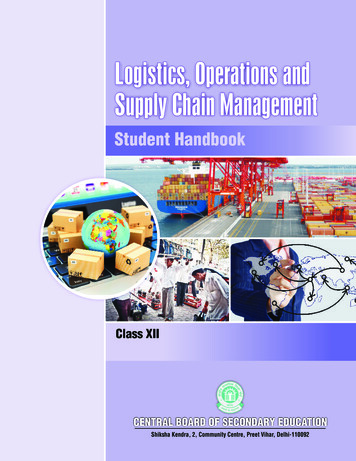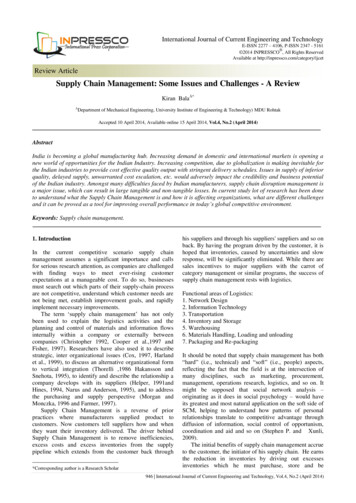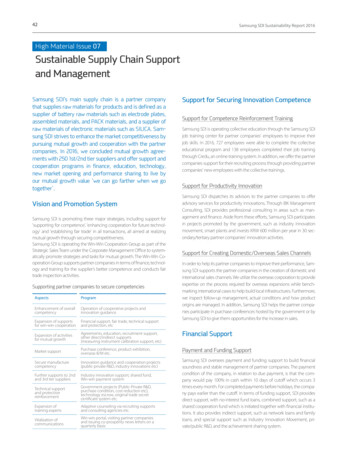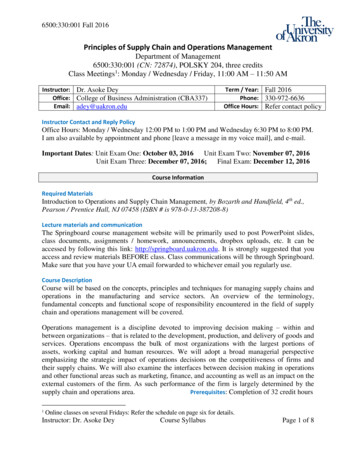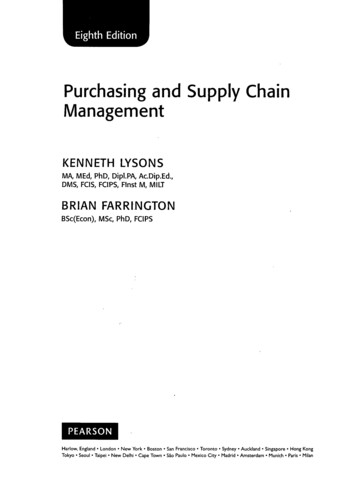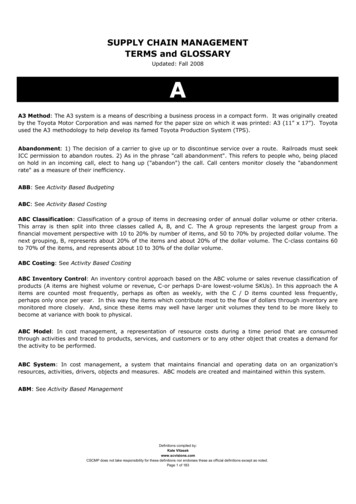
Transcription
SUPPLY CHAIN MANAGEMENTTERMS and GLOSSARYUpdated: Fall 2008AA3 Method: The A3 system is a means of describing a business process in a compact form. It was originally createdby the Toyota Motor Corporation and was named for the paper size on which it was printed: A3 (11” x 17”). Toyotaused the A3 methodology to help develop its famed Toyota Production System (TPS).Abandonment: 1) The decision of a carrier to give up or to discontinue service over a route. Railroads must seekICC permission to abandon routes. 2) As in the phrase "call abandonment". This refers to people who, being placedon hold in an incoming call, elect to hang up ("abandon") the call. Call centers monitor closely the "abandonmentrate" as a measure of their inefficiency.ABB: See Activity Based BudgetingABC: See Activity Based CostingABC Classification: Classification of a group of items in decreasing order of annual dollar volume or other criteria.This array is then split into three classes called A, B, and C. The A group represents the largest group from afinancial movement perspective with 10 to 20% by number of items, and 50 to 70% by projected dollar volume. Thenext grouping, B, represents about 20% of the items and about 20% of the dollar volume. The C-class contains 60to 70% of the items, and represents about 10 to 30% of the dollar volume.ABC Costing: See Activity Based CostingABC Inventory Control: An inventory control approach based on the ABC volume or sales revenue classification ofproducts (A items are highest volume or revenue, C-or perhaps D-are lowest-volume SKUs). In this approach the Aitems are counted most frequently, perhaps as often as weekly, with the C / D items counted less frequently,perhaps only once per year. In this way the items which contribute most to the flow of dollars through inventory aremonitored more closely. And, since these items may well have larger unit volumes they tend to be more likely tobecome at variance with book to physical.ABC Model: In cost management, a representation of resource costs during a time period that are consumedthrough activities and traced to products, services, and customers or to any other object that creates a demand forthe activity to be performed.ABC System: In cost management, a system that maintains financial and operating data on an organization'sresources, activities, drivers, objects and measures. ABC models are created and maintained within this system.ABM: See Activity Based ManagementDefinitions compiled by:Kate Vitasekwww.scvisions.comCSCMP does not take responsibility for these definitions nor endorses these as official definitions except as noted.Page 1 of 183
SUPPLY CHAIN MANAGEMENTTERMS and GLOSSARYUpdated: Fall 2008Abnormal Demand: Demand in any period that is outside the limits established by management policy. Thisdemand may come from a new customer or from existing customers whose own demand is increasing or decreasing.Care must be taken in evaluating the nature of the demand: is it a volume change, is it a change in product mix, oris it related to the timing of the order?Also see: OutlierABP: See Activity Based PlanningAbsorption Costing: In cost management, an approach to inventory valuation in which variable costs and a portionof fixed costs are assigned to or “absorbed” into each unit of production. The fixed costs are usually allocated tounits of output on the basis of direct labor hours, machine hours, or material costs.Synonym: Allocation CostingACAT: See Acquisition CategoriesAcceptable Quality Level (AQL): In quality management, when a continuing series of lots is considered, AQLrepresents a quality level that, for the purposes of sampling inspection, is the limit of a satisfactory process average.Also see: Acceptance SamplingAcceptable Sampling Plan: In quality management, a specific plan that indicates the sampling sizes and theassociated acceptance or non-acceptance criteria to be used.Also see: Acceptance SamplingAcceptance Number: In quality management, 1) A number used in acceptance sampling as a cutoff at which thelot will be accepted or rejected. For example, if x or more units are bad within the sample, the lot will be rejected.2) The value of the test statistic that divides all possible values into acceptance and rejection regions.Also see: Acceptance SamplingAcceptance Sampling: 1) The process of sampling a portion of goods for inspection rather than examining theentire lot. The entire lot may be accepted or rejected based on the sample even though the specific units in the lotare better or worse than the sample. There are two types: attributes sampling and variables sampling. In attributessampling, the presence or absence of a characteristic is noted in each of the units inspected. In variables sampling,the numerical magnitude of a characteristic is measured and recorded for each inspected unit; this type of samplinginvolves reference to a continuous scale of some kind. 2) A method of measuring random samples of lots or batchesof products against predetermined standards.Accessibility: The ability of a carrier to provide service between an origin and a destination.Accessorial charges: A carrier's charge for accessorial services such as loading, unloading, pickup, and delivery.Also see: UpchargesDefinitions compiled by:Kate Vitasekwww.scvisions.comCSCMP does not take responsibility for these definitions nor endorses these as official definitions except as noted.Page 2 of 183
SUPPLY CHAIN MANAGEMENTTERMS and GLOSSARYUpdated: Fall 2008Accessory: A choice or feature added to the good or service offered to the customer for customizing the endproduct. An accessory enhances the capabilities of the product but is not necessary for the basic function of theproduct. In many companies, an accessory means that the choice does not have to be specified before shipment butcan be added at a later date. In other companies, this choice must be made before shipment.Accountability: Being answerable for, but not necessarily personally charged with, doing specific work.Accountability cannot be delegated, but it can be shared. For example, managers and executives are accountable forbusiness performance even though they may not actually perform the work.Accounts Payable (A/P): The value of goods and services acquired for which payment has not yet been made tothe supplier.Accounts receivable (A/R): The value of goods shipped or services rendered to a customer on whom payment hasnot yet been received. Usually includes an allowance for bad debts.Accreditation: Certification by a recognized body of the facilities, capability, objectivity, competence, and integrityof an agency, service, operational group, or individual to provide the specific service or operation needed. Forexample, the Registrar Accreditation Board accredits those organizations that register companies to the ISO 9000Series Standards.Accredited Standards Committee (ASC): A committee of the ANSI chartered in 1979 to develop uniformstandards for the electronic interchange of business documents. The committee develops and maintains U.S. genericstandards (X12) for Electronic Data Interchange.Accumulation bin: A place, usually a physical location, used to accumulate all components that go into anassembly before the assembly is sent out to the assembly floor.Synonym: Assembly binAccuracy: In quality management, the degree of freedom from error or the degree of conformity to a standard.Accuracy is different from precision. For example, four-significant-digit numbers are less precise than six-significantdigit numbers; however, a properly computed four-significant-digit number might be more accurate than animproperly computed six-significant-digit number.ACD: See Automated Call DistributionACE: See Automated Commercial EnvironmentACH: See Automated ClearinghouseAcknowledgment: A communication by a supplier to advise a purchaser that a purchase order has been received.It usually implies acceptance of the order by the supplier.Definitions compiled by:Kate Vitasekwww.scvisions.comCSCMP does not take responsibility for these definitions nor endorses these as official definitions except as noted.Page 3 of 183
SUPPLY CHAIN MANAGEMENTTERMS and GLOSSARYUpdated: Fall 2008Acquisition Categories (ACAT): U.S. DoD ACAT 1 programs are Milestone Decision Authority Programs orprograms designated ACAT 1 by the Milestone Decision Authority.Acquisition Cost: In cost accounting, the cost required to obtain one or more units of an item. It is order quantitytimes unit cost.Action Message: An output of a system that identifies the need for and the type of action to be taken to correct acurrent or potential problem. Examples of action messages in an MRP system include release order, reschedule in,reschedule out, and cancel.Synonym: Exception MessageSynonym: Action ReportAction Plan: A specific method or process to achieve the results called for by one or more objectives. An actionplan may be a simpler version of a project plan.Action Report: See Action MessageActivation: In constraint management, the use of non-constraint resources to make parts or products above thelevel needed to support the system constraint(s). The result is excessive work-in-process inventories or finishedgoods inventories, or both. In contrast, the term utilization is used to describe the situation in which non-constraintresource(s) usage is synchronized to support the needs of the constraint.Active Inventory: The raw materials, work in process, and finished goods that will be used or sold within a givenperiod.Active Stock: Goods in active pick locations and ready for order filling.Activity: Work performed by people, equipment, technologies or facilities. Activities are usually described by the"action-verb-adjective-noun" grammar convention. Activities may occur in a linked sequence and activity-to-activityassignments may exist. 1) In activity-based cost accounting, a task or activity, performed by or at a resource,required in producing the organization's output of goods and services. A resource may be a person, machine, orfacility. Activities are grouped into pools by type of activity and allocated to products. 2) In project management,an element of work on a project. It usually has an anticipated duration, anticipated cost, and expected resourcerequirements. Sometimes "major activity" is used for larger bodies of work.Activity Analysis: The process of identifying and cataloging activities for detailed understanding and documentationof their characteristics. An activity analysis is accomplished by means of interviews, group sessions, questionnaires,observations, and reviews of physical records of work.Activity Based Budgeting (ABB): An approach to budgeting where a company uses an understanding of itsactivities and driver relationships to quantitatively estimate workload and resource requirements as part of anongoing business plan. Budgets show the types, number of and cost of resources that activities are expected toconsume based on forecasted workloads. The budget is part of an organization's activity-based planning processand can be used in evaluating its success in setting and pursuing strategic goals.Definitions compiled by:Kate Vitasekwww.scvisions.comCSCMP does not take responsibility for these definitions nor endorses these as official definitions except as noted.Page 4 of 183
SUPPLY CHAIN MANAGEMENTTERMS and GLOSSARYUpdated: Fall 2008Activity Based Costing (ABC): A methodology that measures the cost and performance of cost objects, activitiesand resources. Cost objects consume activities and activities consume resources. Resource costs are assigned toactivities based on their use of those resources, and activity costs are reassigned to cost objects (outputs) based onthe cost objects proportional use of those activities. Activity-based costing incorporates causal relationshipsbetween cost objects and activities and between activities and resources.Activity Based Costing Model: In activity-based cost accounting, a model, by time period, of resource costscreated because of activities related to products or services or other items causing the activity to be carried out.Activity Based Costing System: A set of activity-based cost accounting models that collectively define data on anorganization's resources, activities, drivers, objects, and measurements.Activity-Based Management (ABM): A discipline focusing on the management of activities within businessprocesses as the route to continuously improve both the value received by customers and the profit earned inproviding that value. ABM uses activity-based cost information and performance measurements to influencemanagement action.See also: Activity-Based CostingActivity Based Planning (ABP): Activity-based planning (ABP) is an ongoing process to determine activity andresource requirements (both financial and operational) based on the ongoing demand of products or services byspecific customer needs. Resource requirements are compared to resources available and capacity issues areidentified and managed. Activity-based budgeting (ABB) is based on the outputs of activity-based planning.Activity Dictionary: A listing and description of activities that provides a common/standard definition of activitiesacross the organization. An activity dictionary can include information about an activity and/or its relationships, suchas activity description, business process, function source, whether value-added, inputs, outputs, supplier, customer,output measures, cost drivers, attributes, tasks, and other information as desired to describe the activity.Activity Driver: The best single quantitative measure of the frequency and intensity of the demands placed on anactivity by cost objects or other activities. It is used to assign activity costs to cost objects or to other activities.Activity Level: A description of types of activities dependent on the functional area. Product-related activity levelsmay include unit, batch, and product levels. Customer-related activity levels may include customer, market,channel, and project levels.Activity Network Diagram: An arrow diagram used in planning and managing processes and projects.Activity Ratio: A financial ratio used to determine how an organization's resources perform relative to the revenuethe resources produce. Activity ratios include inventory turnover, receivables conversion period, fixed-assetturnover, and return on assets.Actual Cost System: A cost system that collects costs historically as they are applied to production and allocatesindirect costs to products based on the specific costs and achieved volume of the products.Definitions compiled by:Kate Vitasekwww.scvisions.comCSCMP does not take responsibility for these definitions nor endorses these as official definitions except as noted.Page 5 of 183
SUPPLY CHAIN MANAGEMENTTERMS and GLOSSARYUpdated: Fall 2008Actual Costs: The labor, material, and associated overhead costs that are charged against a job as it movesthrough the production process.Actual Demand: Actual demand is composed of customer orders (and often allocations of items, ingredients, or rawmaterials to production or distribution). Actual demand nets against or "consumes" the forecast, depending uponthe rules chosen over a time horizon. For example, actual demand will totally replace forecast inside the sold-outcustomer order backlog horizon (often called the demand time fence), but will net against the forecast outside thishorizon based on the chosen forecast consumption rule.Actual to Theoretical Cycle Time: The ratio of the measured time required to produce a given output divided bythe sum of the time required to produce a given output based on the rated efficiency of the machinery and laboroperations.Adaptive Control: 1) The ability of a control system to change its own parameters in response to a measuredchange in operating conditions. 2) Machine control units in which feeds and/or speeds are not fixed. The controlunit, working from feedback sensors, is able to optimize favorable situations by automatically increasing ordecreasing the machining parameters. This process ensures optimum tool life or surface finish and/or machiningcosts or production rates.Adaptive Smoothing: In forecasting, a form of exponential smoothing in which the smoothing constant isautomatically adjusted as a function of one or many items, for example, forecast error measurement, calendarcharacteristics (launch, replenishment, end of life), or demand volume.ADR: See Alternate Dispatch ResolutionAdvance Material Request: Ordering materials before the release of the formal product design. This early releaseis required because of long lead times.Advanced Planning and Scheduling (APS): Techniques that deal with analysis and planning of logistics andmanufacturing over the short, intermediate, and long-term time periods. APS describes any computer program thatuses advanced mathematical algorithms or logic to perform optimization or simulation on finite capacity scheduling,sourcing, capital planning, resource planning, forecasting, demand management, and others. These techniquessimultaneously consider a range of constraints and business rules to provide real-time planning and scheduling,decision support, available-to-promise, and capable-to-promise capabilities. APS often generates and evaluatesmultiple scenarios. Management then selects one scenario to use as the "official plan." The five main components ofAPS systems are demand planning, production planning, production scheduling, distribution planning, andtransportation planning.Advanced Shipping Notice (ASN): Detailed shipment information transmitted to a customer or consignee inadvance of delivery, designating the contents (individual products and quantities of each) and nature of theshipment. In EDI data standards this is referred to as an 856 transaction. May also include carrier and shipmentspecifics including time of shipment and expected time of arrival.See also: Assumed ReceiptDefinitions compiled by:Kate Vitasekwww.scvisions.comCSCMP does not take responsibility for these definitions nor endorses these as official definitions except as noted.Page 6 of 183
SUPPLY CHAIN MANAGEMENTTERMS and GLOSSARYUpdated: Fall 2008After-Sale Service: Services provided to the customer after products have been delivered. This can includerepairs, maintenance and/or telephone support.Synonym: Field ServiceAgency tariff: A publication of a rate bureau that contains rates for many carriers.Agglomeration: A net advantage gained by a common location with other companies.Aggregate Forecast: An estimate of sales, often time phased, for a grouping of products or product familiesproduced by a facility or firm. Stated in terms of units, dollars, or both, the aggregate forecast is used for sales andproduction planning (or for sales and operations planning) purposes.Aggregate Inventory: The inventory for any grouping of items or products involving multiple stock-keeping units.See also: Base Inventory LevelAggregate Inventory Management: Establishing the overall level (dollar value) of inventory desired andimplementing controls to achieve this goal.Aggregate Plan: A plan that includes budgeted levels of finished goods, inventory, production backlogs, andchanges in the workforce to support the production strategy. Aggregated information (e.g., product line, family)rather than product information is used, hence the name aggregate plan.Aggregate Planning: A process to develop tactical plans to support the organization's business plan. Aggregateplanning usually includes the development, analysis, and maintenance of plans for total sales, total production,targeted inventory, and targeted customer backlog for families of products. The production plan is the result of theaggregate planning process. Two approaches to aggregate planning exist-production planning and sales andoperations planning.Aggregate tender rate: A reduced rate offered to a sh
Updated: Fall 2008 TERMS and GLOSSARY SUPPLY CHAIN MANAGEMENT Absorption Costing: In cost management, an approach to inventory valuation in which variable costs and a portion of fixed costs ar



